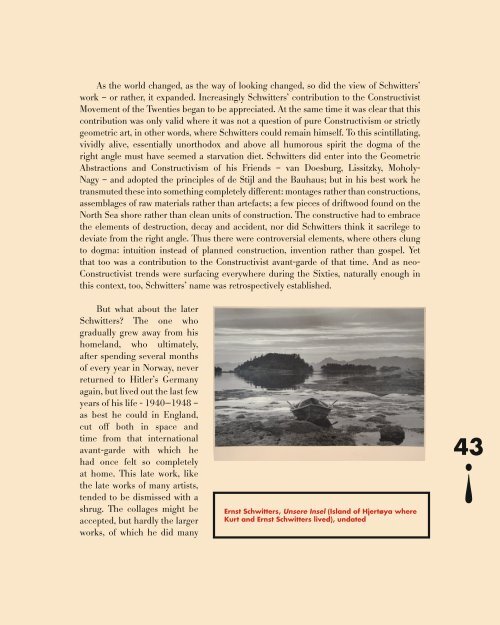Kurt Schwitters: Merz (2016) – Norman Rosenthal interviews Damien Hirst
Fully illustrated catalog published by Galerie Gmurzynska in collaboration with Cabaret Voltaire Zurich on the occasion of Kurt Schwitters: MERZ, a major retrospective exhibition celebrating 100 years of Dada. The exhibition builds and expands on the gallery’s five decade long exhibition history with the artist, featuring exhibition architecture by Zaha Hadid. Edited by Krystyna Gmurzynska and Mathias Rastorfer. First of three planned volumes containing original writings by Kurt Schwitters, historical essays by Ernst Schwitters, Ad Reinhardt and Werner Schmalenbach as well as text contributions by Siegfried Gohr, Adrian Notz, Jonathan Fineberg, Karin Orchard, and Flavin Judd. Foreword by Krystyna Gmurzynska and Mathias Rastorfer. Interview with Damien Hirst conducted by Norman Rosenthal. Includes full color plates and archival photographs. 174 pages, color and b/w illustrations. English. ISBN: 978-3-905792-33-1 The publication includes an Interview with Damien Hirst by Sir Norman Rosenthal about the importance of Kurt Schwitters's practice for Hirst's work.
Fully illustrated catalog published by Galerie Gmurzynska in collaboration with Cabaret Voltaire Zurich on the occasion of Kurt Schwitters: MERZ, a major retrospective exhibition celebrating 100 years of Dada. The exhibition builds and expands on the gallery’s five decade long exhibition history with the artist, featuring exhibition architecture by Zaha Hadid.
Edited by Krystyna Gmurzynska and Mathias Rastorfer.
First of three planned volumes containing original writings by Kurt Schwitters, historical essays by Ernst Schwitters, Ad Reinhardt and Werner Schmalenbach as well as text contributions by Siegfried Gohr, Adrian Notz, Jonathan Fineberg, Karin Orchard, and Flavin Judd.
Foreword by Krystyna Gmurzynska and Mathias Rastorfer.
Interview with Damien Hirst conducted by Norman Rosenthal.
Includes full color plates and archival photographs.
174 pages, color and b/w illustrations.
English.
ISBN:
978-3-905792-33-1
The publication includes an Interview with Damien Hirst by Sir Norman Rosenthal about the importance of Kurt Schwitters's practice for Hirst's work.
You also want an ePaper? Increase the reach of your titles
YUMPU automatically turns print PDFs into web optimized ePapers that Google loves.
As the world changed, as the way of looking changed, so did the view of <strong>Schwitters</strong>’<br />
work – or rather, it expanded. Increasingly <strong>Schwitters</strong>’ contribution to the Constructivist<br />
Movement of the Twenties began to be appreciated. At the same time it was clear that this<br />
contribution was only valid where it was not a question of pure Constructivism or strictly<br />
geometric art, in other words, where <strong>Schwitters</strong> could remain himself. To this scintillating,<br />
vividly alive, essentially unorthodox and above all humorous spirit the dogma of the<br />
right angle must have seemed a starvation diet. <strong>Schwitters</strong> did enter into the Geometric<br />
Abstractions and Constructivism of his Friends – van Doesburg, Lissitzky, Moholy-<br />
Nagy – and adopted the principles of de Stijl and the Bauhaus; but in his best work he<br />
transmuted these into something completely different: montages rather than constructions,<br />
assemblages of raw materials rather than artefacts; a few pieces of driftwood found on the<br />
North Sea shore rather than clean units of construction. The constructive had to embrace<br />
the elements of destruction, decay and accident, nor did <strong>Schwitters</strong> think it sacrilege to<br />
deviate from the right angle. Thus there were controversial elements, where others clung<br />
to dogma: intuition instead of planned construction, invention rather than gospel. Yet<br />
that too was a contribution to the Constructivist avant-garde of that time. And as neo-<br />
Constructivist trends were surfacing everywhere during the Sixties, naturally enough in<br />
this context, too, <strong>Schwitters</strong>’ name was retrospectively established.<br />
But what about the later<br />
<strong>Schwitters</strong>? The one who<br />
gradually grew away from his<br />
homeland, who ultimately,<br />
after spending several months<br />
of every year in Norway, never<br />
returned to Hitler’s Germany<br />
again, but lived out the last few<br />
years of his life - 1940—1948 –<br />
as best he could in England,<br />
cut off both in space and<br />
time from that international<br />
avant-garde with which he<br />
had once felt so completely<br />
at home. This late work, like<br />
the late works of many artists,<br />
tended to be dismissed with a<br />
shrug. The collages might be<br />
accepted, but hardly the larger<br />
works, of which he did many<br />
Ernst <strong>Schwitters</strong>, Unsere Insel (Island of Hjertøya where<br />
<strong>Kurt</strong> and Ernst <strong>Schwitters</strong> lived), undated<br />
43!

















